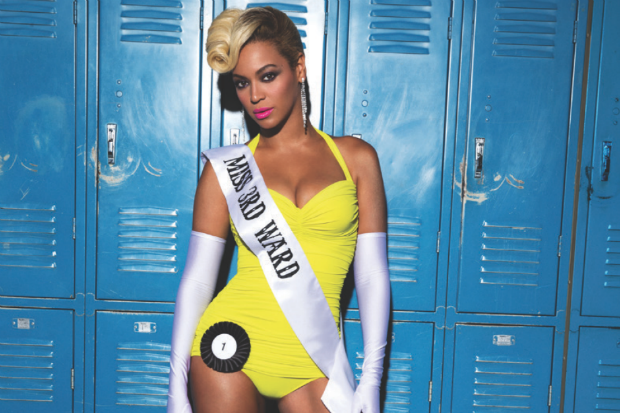 The songs on Beyoncé’s fifth studio album, BEYONCÉ, are fine. They’re good songs that sound like the music Beyoncé makes, which is what people like to listen to. The music on the album is whatever and absolutely besides the point because OH MY GOD BEY JUST BROUGHT THE INTERNET TO A GRINDING HALT. Beyoncé unexpectedly dropping a 14-song album and the 17 corresponding music videos plus credits exclusively on iTunes—and the ensuing collective Internet swoon—makes Beyoncé pop culture’s truest celebrity and genius. But the mega-stardom and brilliance of Beyoncé and her album succeeds either because of, or in spite of her “visual album” presenting a form of pastiche as devoid of substantive value as Upworthy, and not even half as inspired.
The songs on Beyoncé’s fifth studio album, BEYONCÉ, are fine. They’re good songs that sound like the music Beyoncé makes, which is what people like to listen to. The music on the album is whatever and absolutely besides the point because OH MY GOD BEY JUST BROUGHT THE INTERNET TO A GRINDING HALT. Beyoncé unexpectedly dropping a 14-song album and the 17 corresponding music videos plus credits exclusively on iTunes—and the ensuing collective Internet swoon—makes Beyoncé pop culture’s truest celebrity and genius. But the mega-stardom and brilliance of Beyoncé and her album succeeds either because of, or in spite of her “visual album” presenting a form of pastiche as devoid of substantive value as Upworthy, and not even half as inspired.
These 17 videos feature a mind-spinningly eclectic imitation and appropriation of symbols, ideas, references, and visual or musical styles tossed together with the same reckless abandon of her hair flips, but without an ounce of concern for concerns like “flow,” “thematic unity,” or “wait, why the fuck are there statues dancing in the desert in ‘Mine?’” She’s celebrating every motif of contemporary pop culture she can, from the imagery of the Dirty South in “No Angel” to Donna Summers’ hair in “Blow,” but rather than employing this intertexuality to say something interesting, she just kind of thrusts and shows off her cleavage and assumes including the audio of Chimamanda Ngozi Adiche’s Ted Talk in “***Flawless” can do the work of actually saying something new and interesting on her album.
Maybe ‘pastiche’ is even the wrong word to use here, suggesting that Beyoncé’s giving far more credit to the artist’s she is referencing than she actually does. Bricolage—the practice of creating artwork from found things at one’s disposal—sounds far more appropriate for most of BEYONCÉ. Half of the videos seem like Beyoncé hired a small army of graduate students and performance artists to inject more symbolism in each song than the entire New Testament. You want artsy? Here’s “Haunted” Bey in a pantsuit on loan from Janelle Monae (the one and only time Beyoncé can be caught wearing pants throughout the visual album, by my count) walking past characters from Dead Presidents. Too hipster? How about Sasha Fierce in “Drunk in Love” literally getting wet just thinking about Jay-Z. BOOM, you just got metaphored.
The fact that Jay-Z, in the “Drunk in Love” video, literally does have the hottest chick in the game wearing his chain may be the most fully-realized metaphor in the whole album. So what if Beyoncé’s coat in “New Angel” probably costs more than most of the Houston homes she shows? Class differences are something Bey just wants to depict, not explore. Same goes for her treatment of race (Beyoncé always presenting herself as an ambiguous racial identity between black and white bodies), beauty standards (sexuality (WHY DOESN’T SHE WEAR PANTS). Beyoncé seems to conflate being the pop intellectual-cum-artist she wants to be with ramming a hodgepodge of images into a 6-minute video. It’s undeniably cool to show Beyoncé and Frank Ocean joining revolutionary forces in “Superpower,” but that doesn’t mean the video actually says anything of interest.
The other half of the videos—those not devoted to either a) saying “hey symbolism” or b) filming Beyoncé dragging her fingernails along various surfaces and body parts—are hell-bent on reveling in Bey’s body. Beyoncé’s prior albums like 2008’s I Am… Sasha Fierce and 2011’s 4 forged an appealing feminist-ish ideology that melded sexuality with assertive female independence. Gone are the female call-to-arms of “Best Thing I Never Had” or “Run the World (Girls), or eve n the complex R&B feel-good monogamous love vibes of “Love on Top” or “Countown,” as Beyoncé returns to reminding the world how goddamn desirable she is. But unlike her early 2000s sex-appeal that was predicated on Bey’s sexual unattainability, songs like “Partition” and “Drunk in Love” make it readily apparent how available she is for the man (Jay-Z) who is quickly become the Eugene Levy of the rap game. Beyoncé may start off the album with “Pretty Hurts,” a critique of the effects of unattainable beauty standards on women, but it’s hard to take that claim seriously when she spends the rest of her time showing off her impossibly-beautiful body in “Blow” or “Yoncé” and pretty much everything else too.
Self-expression and empowerment through sexuality is cool and all, but isn’t there more to talk about than showing off some high-grade T&A? Just once I want Jay and Bey to make a music video about playing Scrabble after a long day of teaching Blue Ivy the proper mechanics of securing royalty rights.
But do any of these concerns really matter? At the end of the day, Beyoncé just proved that she’s the biggest star in the world by releasing an album that screams her name in all-caps that took a Miley Cyrus-sized wrecking ball to Facebook newsfeeds everywhere. And the videos are fundamentally awesome, a celebration of Beyoncé having a sexy body and great life where she can make fun songs that some people should just be dancing too rather than spending their time figuring out how to goddamn put that accent mark when you have to capitalize the ‘e’ in BEYONCÉ. The album is sexy and catchy and will be played on the radio until the next Beyoncé album comes around, and Beyoncé the diva once again proves she can effortlessly control the world’s attention (or at least appear like the process is effortless) at a moment’s notice.
Releasing an astounding 17 videos simultaneously with the album, in particular, is what makes the album almost as epically brilliant as one of Beyoncé’s diamond-clad leotards. As Ms. Knowles made pretty damn clear with “All the Single Ladies,” her songs’ ideology of assertively independent femininity is inextricably tied to her music videos. And the videos are what makes this collection of songs, and Beyoncé herself, important.
According to Malcolm Gladwell and Bill Simmons, true celebrity means parlaying one's talent and appeal into high expectations. That Beyoncé could fulfill those expectations with an album that surprised every American is the mark of her genius. So what if she doesn't use her veritable shit-ton of imagery in a meaningful way? Releasing an album that you, me, and your grandmother couldn't help but hear about and consume is meaningful in and of itself, and the sign of Beyoncé's true genius.




